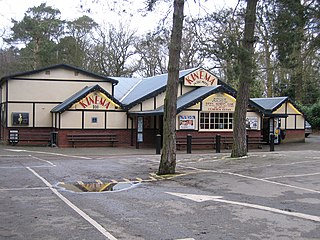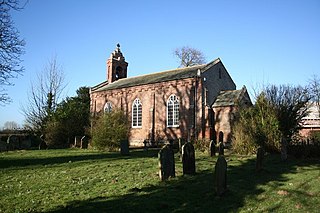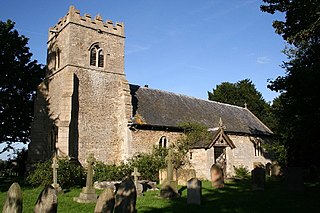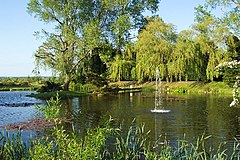
Nocton is a village and civil parish in the North Kesteven district of Lincolnshire, England. It is situated on the B1202 road, 7 miles (11 km) south-east from Lincoln city centre. The population of the civil parish at the 2011 census was 819. To the east of the village is Nocton Fen with its small settlement of Wasps Nest. To the west of the village, situated at the junction of Wellhead Lane and the B1188 road, is Nocton Top Cottages consisting of eight further dwellings. At the south of the village are the remains of Nocton Hall, and 1 mile (2 km) to the east the earthwork remains of Nocton Park Priory.

Bardney is a village and civil parish in the West Lindsey district of Lincolnshire, England. The population of the civil parish was 1,643 at the 2001 census increasing to 1,848 at the 2011 census. The village sits on the east bank of the River Witham and 9 miles (14 km) east of Lincoln.

Authorpe is a village and civil parish in the East Lindsey district of Lincolnshire, England. It is situated between the A16 and the A157 roads, 6 miles (10 km) south-east from Louth and 4.5 miles (7 km) north-west from Alford.

Barlings and Low Barlings are two small hamlets lying south off the A158 road at Langworth, about 7 miles (11 km) east of Lincoln in the West Lindsey district of Lincolnshire, England. Low Barlings is a scattered collection of homes, situated along a trackway south from Barlings towards boggy ground near the River Witham. Both hamlets are in the civil parish of Barlings. The population of the civil parish at the 2011 census was 460.

Woodhall Spa is a former spa town and civil parish in the East Lindsey district of Lincolnshire, England, on the southern edge of the Lincolnshire Wolds, 6 miles (10 km) south-west of Horncastle, 23 miles (37 km) west of Skegness, 15 miles (24 km) east-south-east of Lincoln and 17 miles (27 km) north-west of Boston. It is noted for its mineral springs, historic cinema and its Second World War association with the RAF 617 Squadron, commonly referred to as 'The Dambusters'.

Aslackby and Laughton is a civil parish in the South Kesteven district of Lincolnshire, England. According to the 2001 census the parish had a population of 243, in 102 households. increasing slightly to 251 in 118 households at the 2011 census. It consists of the village of Aslackby, the hamlet of Laughton, and scattered farms, and part of the hamlet of Graby.

Bucknall is a village and civil parish in the East Lindsey district of Lincolnshire, England. The village is situated approximately 5 miles (8 km) west from Horncastle and 5 miles (8 km) north from Woodhall Spa.

Roughton is a village and civil parish in the East Lindsey district of Lincolnshire, England. The parish population was 644 in 2011.

Old Woodhall or Woodhall, is a village and former civil parish, now in the parish of Stixwould and Woodhall, in the East Lindsey district, in the county of Lincolnshire, England. It is located about 3 miles (4.8 km) south west of Horncastle. In 1961 the parish had a population of 123.

Langrick is a small village in the East Lindsey district of Lincolnshire, England. It is in the civil parish of Langriville, and on the B1192 road, 5 miles (8 km) north-west from Boston. The village lies in the Lincolnshire Fens, and less than 1 mile (1.6 km) east from the River Witham.

The Lincolnshire loop line was a railway built by the Great Northern Railway, that linked Peterborough to Gainsborough via Spalding, Boston and Lincoln. It ran through the counties of Lincolnshire and Northamptonshire

Horsington is a village and civil parish in the East Lindsey district of Lincolnshire, England. It lies on the B1190, 4 miles (6.4 km) north from Woodhall Spa and 6 miles (10 km) west from Horncastle as well as 6 miles east of Bardney. The parish includes the hamlet of Poolham which is situated 0.90 mi (1.45 km) to the east of the village.

Keddington is a village and civil parish in the East Lindsey district of Lincolnshire, England. It is 2 miles (3 km) north-east from Louth.

Knaith is a village and civil parish about 3 miles (5 km) south of the town of Gainsborough in the West Lindsey district of Lincolnshire, England. The population of the civil parish at the 2011 census was 335.

Market Stainton is a village and civil parish in the East Lindsey district of Lincolnshire, England. It is situated approximately 7 miles (11 km) north from the market town of Horncastle.

Laughton is a village and a civil parish in the West Lindsey district of Lincolnshire, England. The population of the civil parish at the 2011 census was 410. It is situated approximately 6 miles (10 km) north from the town of Gainsborough

North Ormsby is a village and civil parish in the East Lindsey district of Lincolnshire, England. It is situated approximately 7 miles (11 km) north-west from the market town of Louth.

Thurlby is a village and civil parish in the North Kesteven district of Lincolnshire, England, about 9 miles (14 km) south-west of the city of Lincoln and about 9 miles (14 km) north-east of the town of Newark-on-Trent. It is most notable for Thurlby Hall, home of the Bromhead baronets. The population is included in the civil parish of Witham St Hughs.

Weston is a village and civil parish in the South Holland district of Lincolnshire, England. It is situated approximately 2 miles (3 km) north-east from the town of Spalding. The Civil Parish also includes Weston Hills. The population of the civil parish including Austendike was at the 2011 census 2,054.
Kingthorpe is a hamlet in the West Lindsey district of Lincolnshire, England. The hamlet is in the civil parish of Apley, and is 10 miles (16 km) east from the city and county town of Lincoln and 9 miles (14 km) south from the market town of Market Rasen. It sits on the B1202 road from Wragby to Bardney, and 1 mile (1.6 km) to the east from the parish village of Apley.























